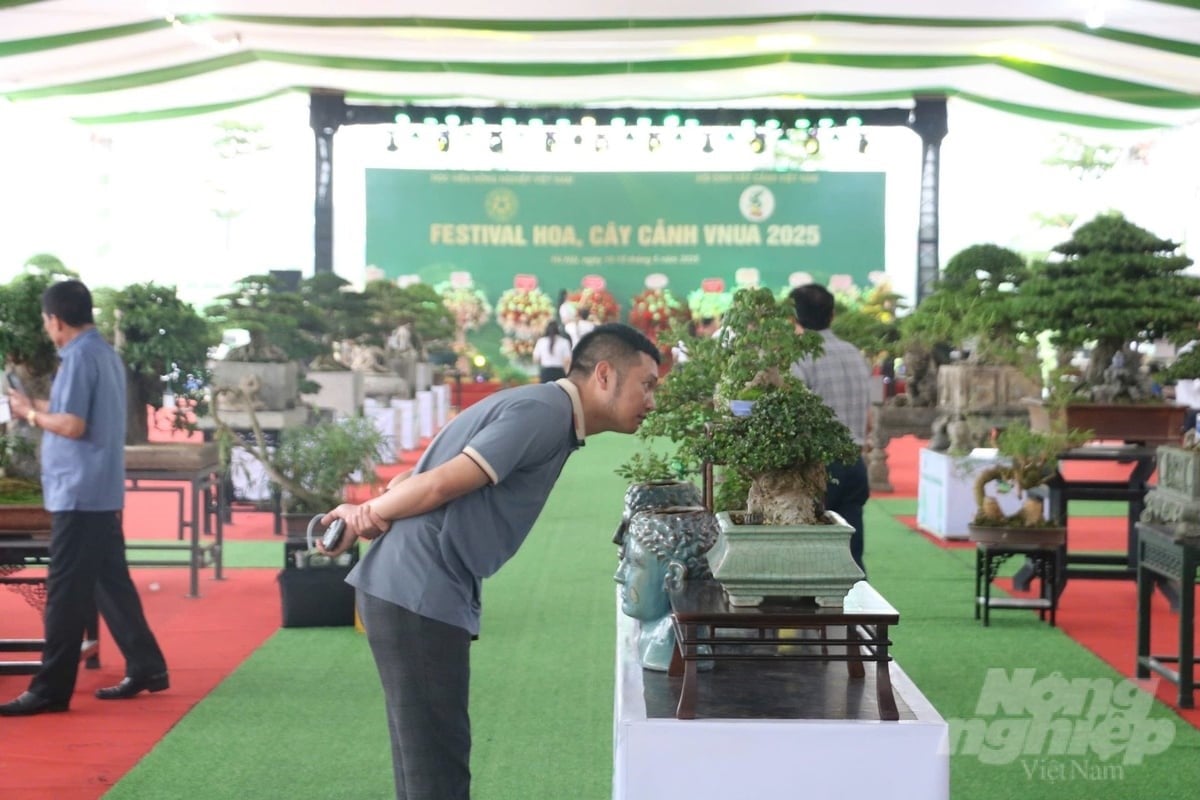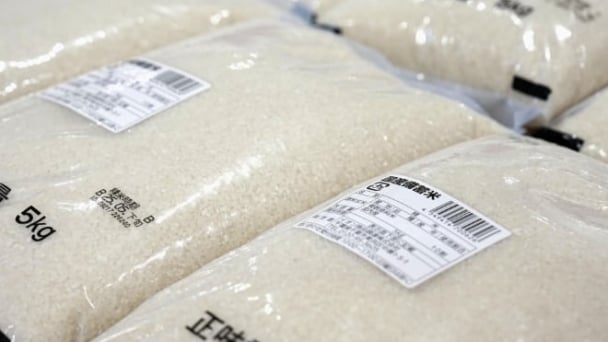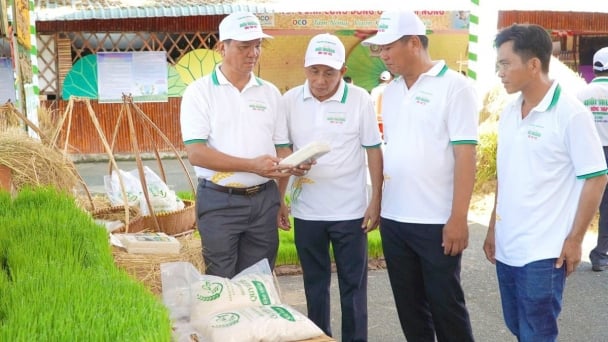June 12, 2025 | 01:01 GMT +7
June 12, 2025 | 01:01 GMT +7
Hotline: 0913.378.918
June 12, 2025 | 01:01 GMT +7
Hotline: 0913.378.918
The Vietnam National University of Agriculture (VNUA) has just inaugurated the VNUA Flower-Ornamental Plant Festival 2025, with the participation of hundreds of gardeners and enterprises operating in floriculture.

The VNUA Flower-Ornamental Plant Festival 2025. Photo: Hung Giang.
Dr. Nguyen Thi Lan, Director of the VNUA, said that the floriculture and ornamental plant industry is increasingly asserting its role in Vietnam’s modern agriculture. The industry currently has a growing area of approximately 45,000 ha, with an annual output of 6 million stems and a production value exceeding VND 45 trillion (around USD 1.8 billion). Export turnover has surpassed USD 100 million. Major flower varieties for export include roses, chrysanthemums, and moth orchids (Phalaenopsis), with key markets being Japan, South Korea, the Netherlands, and Australia.
High-tech flower farming areas have taken shape in several localities, such as Da Lat, Hanoi, and Ho Chi Minh City. Domestic demand is growing at a rate of 10–15%/year, with average per capita spending on flowers and ornamental plants reaching VND 45,000/year (nearly USD 1.8/year) for various purposes.

Dr. Nguyen Thi Lan, Director of the Vietnam National University of Agriculture, delivers the opening speech at the ceremony. Photo: Hung Giang.
Deputy Minister of Agriculture and Environment Hoang Trung affirmed that floricultural and ornamental plants are a growing industry that receives significant global attention. In 2024, the global market for cut flower exports reached a revenue of USD 3.45 billion, with an annual growth rate of 8%.
In Europe, floriculture and ornamental plants account for just 12% of the global floriculture and ornamental plant cultivation area but generate 42% of total production value, making it the region with the highest level of intensive farming. The average production value in Europe is EUR 120,000/ha. In comparison, the proportion of flowers and ornamental plants grown in greenhouses is 17% in China and 51% in Japan, with average yields of EUR 10,000 and EUR 140,000/ha/year, respectively.
With its inherent strengths and potential, Vietnam is fully capable of developing such models, provided there is strong engagement from central to local levels, as well as from research and training units to businesses and artisans.
Deputy Minister Hoang Trung outlined five key solution groups that need to be implemented synchronously to develop floriculture and ornamental plants into a sustainable economic sector.
First, perfect the institutions, mechanisms, and policies to formally recognize floriculture and ornamental plants as an economic sector within the national crop production structure. Build preferential policies on credit, land use, and taxes to encourage businesses' investment. Review and amend the "Developing the flower and ornamental plant industry by 2030" project in line with current practical situations.
Second, production in floriculture should be restructured to promote professionalism and efficiency. This entails developing specialized cultivation areas concentrated in localities with comparative advantages and promoting the formation of cooperatives, cooperative groups, and linkage chains led by enterprise-centered partnerships.
“We must build an ecosystem for the flower and ornamental plant industry, where each product is not only of high quality and aesthetic value but also identified, traceable, certified for sustainability, and tradeable on digital platforms within global supply chains,” Deputy Minister Hoang Trung emphasized.
Third, accelerate scientific research and the application of technologies. This includes breeding high-value flower varieties, particularly Indigenous species, and adopting high-tech practices such as greenhouse cultivation, drip irrigation, tissue culture, artificial intelligence (AI), and the Internet of Things (IoT) across production, preservation, and distribution processes. At the same time, support the establishment of flower technology centers, seedling nurseries, and modern pre-processing and preservation stations.
Fourth, expand markets in floriculture and build a strong brand. Efforts will focus on developing domestic consumption markets through e-commerce and modern distribution systems, in conjunction with ecotourism activities. They will also promote exports, take advantage of free trade agreements, and build a national brand for Vietnamese flowers. Additionally, they will explore the formation of a nationwide flower and ornamental plant trading floor network or alliance capable of connecting and sharing data with major regional and global trading floors.

Deputy Minister Hoang Trung spoke at the ceremony. Photo: Hung Giang.
Fifth, human resources should be developed, and management capacity improved. This includes expanding vocational training and skill development in the production, shaping, and care of flowers and ornamental plants for farmers and artisans. Build specialized training programs in flowers and ornamental plants at universities and colleges. Promote the role of research institutes, the Vietnam Ornamental Creatures Association, and the Vietnam National University of Agriculture in education, research, and policy consulting.
Dr. Pham Van Cuong, Deputy Director of the VNUA, stated that in recent years, Vietnam's flower and ornamental plant industry has grown impressively and emerged as a promising economic industry.
However, he also pointed out that the industry is facing numerous challenges, including the lack of rational planning for specialized cultivation areas, limited production and preservation technologies, low competitiveness, and increasing impacts from climate change. These challenges demand synchronous and breakthrough solutions to develop the industry toward modernization, sustainability, and efficiency.
Proposing six solutions for developing Vietnam’s flower and ornamental plant industry, Ms. Duong Thi Nga, Deputy Director of the Northern Plant Production and Protection Center (under the Crop Production and Plant Protection Department), pays attention to science- and technology-based solutions.

In recent years, Vietnam’s flower and ornamental plant industry has made impressive growth, emerging as one of the promising economic sectors. Photo: Hung Giang.
Accordingly, it is essential to create favorable conditions for organizations and individuals to research, breed, and import new flower and ornamental plant varieties. This will help meet the growing demand for aesthetic, cultural, and functional values from both domestic and international customers.
In addition, the technological process for producing flowers and ornamental plants should be studied and improved, starting with breeding, planting, caring, and pruning and ending with harvesting, pre-processing, and preservation. This would encourage the application of sustainable cultivation practices.
Ms. Duong Thi Nga also proposed continued conservation and expansion of the genetic resources of flowers and ornamental plants. This would enrich the diversity of commercial products and provide genetic material for breeding flower and ornamental plant varieties.
At the same time, priority should be given to the transfer and application of new technologies and digital tools in the management, production, and consumption of ornamental plants and floriculture. It is also necessary to review, supplement, and adjust standards and norms related to floriculture and ornamental plants.
Translated by Thu Huyen
/2025/06/11/3507-1-161904_583.jpg)
(VAN) Seagrass beds and coral reefs serve as 'cradles' that nurture life in the ocean depths, creating rich aquatic resources in Vietnamese waters.
![Turning wind and rain into action: [1] Forecasting for farmers](https://t.ex-cdn.com/nongnghiepmoitruong.vn/608w/files/news/2025/06/11/e5a48259d6a262fc3bb3-nongnghiep-111919.jpg)
(VAN) Weather is no longer just a matter of fate. Forecasts have now become an essential companion for farmers in every crop season.
/2025/06/10/2501-3-082025_983.jpg)
(VAN) Mr. Le Hoang Minh, Head of Vinamilk's Net Zero project, recently shared insights on the integration of production, energy, and technology in Vinamilk’s green transition journey.

(VAN) Over half of large-scale rice producers feel that store prices for rice are 'too high', indicating that many of them share concerns with consumers about the elevated cost of the staple food in Japan.

(VAN) Dong Thap has launched a meeting in response to the Action Month for the Environment under the theme 'Live Green - Join Hands for a Green Economy' at Tram Chim National Park.

(VAN) The ocean has the capacity to absorb millions of tons of carbon, provided that mangrove forests, coral reefs, and biodiversity are protected.

(VAN) Technology is redrawing the map of Vietnamese aquaculture: more modern, greener, and more sustainable.